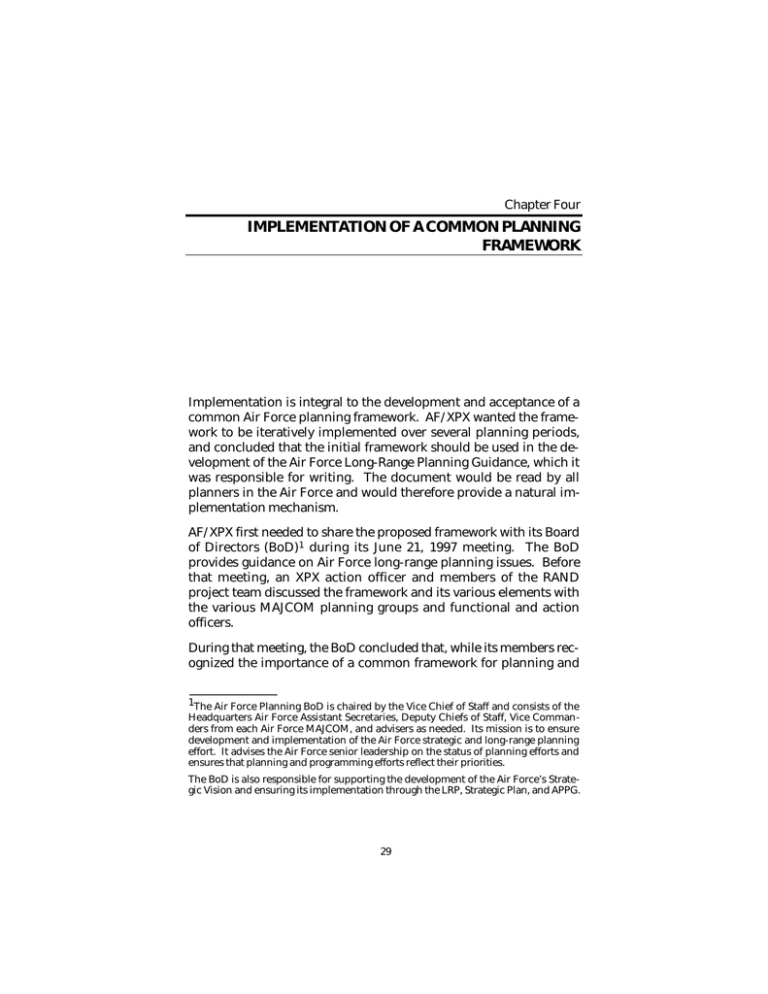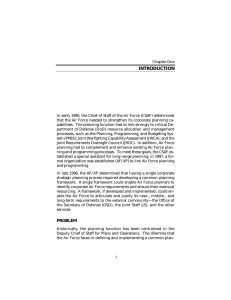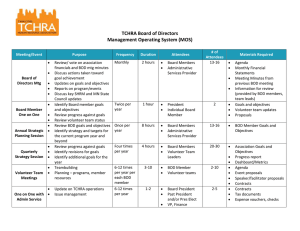IMPLEMENTATION OF A COMMON PLANNING FRAMEWORK
advertisement

Chapter Four IMPLEMENTATION OF A COMMON PLANNING FRAMEWORK Implementation is integral to the development and acceptance of a common Air Force planning framework. AF/XPX wanted the framework to be iteratively implemented over several planning periods, and concluded that the initial framework should be used in the development of the Air Force Long-Range Planning Guidance, which it was responsible for writing. The document would be read by all planners in the Air Force and would therefore provide a natural implementation mechanism. AF/XPX first needed to share the proposed framework with its Board of Directors (BoD)1 during its June 21, 1997 meeting. The BoD provides guidance on Air Force long-range planning issues. Before that meeting, an XPX action officer and members of the RAND project team discussed the framework and its various elements with the various MAJCOM planning groups and functional and action officers. During that meeting, the BoD concluded that, while its members recognized the importance of a common framework for planning and ______________ 1The Air Force Planning BoD is chaired by the Vice Chief of Staff and consists of the Headquarters Air Force Assistant Secretaries, Deputy Chiefs of Staff, Vice Commanders from each Air Force MAJCOM, and advisers as needed. Its mission is to ensure development and implementation of the Air Force strategic and long-range planning effort. It advises the Air Force senior leadership on the status of planning efforts and ensures that planning and programming efforts reflect their priorities. The BoD is also responsible for supporting the development of the Air Force’s Strategic Vision and ensuring its implementation through the LRP, Strategic Plan, and APPG. 29 30 Defining a Common Planning Framework for the Air Force resourcing both the operational and Title 10 requirements, the proposed planning areas were confusing in light of the work done by the Air Force on the development of an agreed-upon set of core competencies. All Air Force planning and programming should be based on the core competencies. The XPX representatives indicated that the core competencies were too broad and lacked specificity for planning and resourcing purposes; they further noted that the core competencies were embedded in the various planning areas. Nonetheless, the BoD concluded that, while the concept of a common planning framework is valid, the framework should be based on the Air Force’s core competencies. They further indicated that the MAJCOMs should continue to perform their various planning and programming activities and that the work at XPX was to integrate the outputs of the functional organizations and MAJCOMs. After the BoD meeting, XPX and RAND realigned the planning areas along the core competencies and key enablers. The planning areas were now: • Air and space superiority • Global attack and precision engagement • Rapid global mobility • Information superiority • Agile combat support, quality people, global awareness, and Command and control • Innovation. The capabilities and tasks were then realigned according to each core competency and enabler. The realignment of the framework along core competencies recreated the very problem that the common planning framework was attempting to solve: the stovepipes that inhibited the Air Force leadership’s ability to identify critical cross-cutting planning and resourcing issues. In response to this insight, the Air Force leadership determined that a horizontal integration mechanism was needed to identify the cross-cutting issues. The horizontal inte- Implementation of a Common Planning Framework 31 gration mechanism was called thrust areas—areas calling for special Air Force emphasis. They identified corporately approved, longrange priorities that will shape the future Air Force and its core capabilities. Six thrust areas were identified, three operational and three institutional. (Note: The AF BoD decided to terminate the thrust areas because they were too broad, potentially duplicative, and resource intensive.) The operational thrust areas were: • Conduct seamless aerospace force • Maintain a credible nuclear deterrent • Find, fix, track, target, and engage. The institutional areas were: • Be an expeditionary aerospace force • Develop the airman of the future • Shape infrastructure for future aerospace force. The XPX refined the thrust areas as a means of providing the critical horizontal integration across the core competencies and the various MAJCOM and functional planning and resourcing activities. Transformation plans were to set the performance targets for each thrust area and establish the means and paths to transition from where the Air Force is now to where it wants to be in the future (Murdock, 1998). Thrust area transformation plans (TATPs) would then describe integrated paths to the future. TATPs would have been created by integrating functional requirements and incorporating long-range plan end states and decision points. To achieve required end states and capability targets, divestiture and investment were intrinsic in the TATP development process. The TATPs would also inform integrated, phased, and prioritized investment/divestment resource streams, in addition to providing the foundation for future POMs driven by long-range priorities. The process of aggregating Air Force requirements to a thrust area begins with the identification of independent capabilities to ensure compatible timing, which is then adjusted for technological risk. The 32 Defining a Common Planning Framework for the Air Force outcome of the initial step is the aggregation of all related capabilities drawn from numerous sources. The next step is to determine the major investment and divestiture options. Following this step, the integration effort will be technologically, but not yet fiscally, constrained. The TATPs would then be synthesized through a corporate process involving the Air Force Group2 (Murdock, 1998). The outcome was envisioned to be prioritization and phasing of the thrust areas to achieve capability targets. The corporate integration process would have required several trade-offs to stay within the constraints. Trade-offs would have been made between thrust areas to create and ensure an affordable modernization program with temporal considerations. The synthesized TATPs were to be adjusted over time to reflect technological developments and competing priorities and should be reviewed when the Vision is revisited every four years. The BoD, with the assistance of XPXP, has concluded that the role of Air Force planning is to provide strategic direction to the MAJCOMs. The existing processes, such as the CORONAs and the BoD meetings, enable the Air Force to provide horizontal integration across the institution. This process ensures that both institutional and operational issues are addressed at the MAJCOM and senior leadership levels. The Air Force leadership continues to struggle with the issue of who really has the responsibility for corporate Air Force planning: Should the process be handled by the MAJCOMs with some overarching headquarters’ guidance? Or should the process be highly centralized with headquarters establishing the broad institutional guidance for the MAJCOMs, which would in turn develop and implement their own initiatives in response to the guidance? Recently, the Air Force leadership decided that XPP should provide broad guidelines for change, but that the MAJCOMs should retain their planning and programming. The integration mechanism will ______________ 2 The Air Force Group consists of the Air Force panels and other headquarters offices and is chaired by the Deputy Director of XPP, Brigadier General Tom Goslin. The Group provides senior-level (colonel and civilian equivalent) resolution of resource allocation and other issues prior to Air Force Board review. It also develops the overall integrated Air Force program for submission to the Air Force Board. Implementation of a Common Planning Framework 33 be the AFTLs, which are derived from the UJTLs. Although each MAJCOM developed its own unique task list, the lists provide a mechanism for horizontal integration by ensuring that all planning and resourcing activities are linked to the UJTLs and the broadly articulated Air Force plans contained in the LRP. The common planning framework described in this report was not adopted in part because it ran counter to the UJTL and the AFTL that was designed to fit within the UJTL structure. UJTL and AFTL appear to provide an already existing hierarchy of objectives developed according to a strategies-to-tasks approach. They are essentially lists of objectives that extend from the strategic to tactical level and they are authoritative, i.e., formally accepted by the Joint Staff and the Air Force. AFTL is structured around the Air Force core competencies and it includes those tasks required to train, organize, and equip aerospace forces, i.e., functions performed by a service under Title 10. Since UJTL and AFTL are already in place, the Air Force would risk causing confusion if it were to adopt a different set of objectives to support its long-range planning. Could the Air Force adopt the UJTL and AFTL to support its own planning process? Ostensibly it could, but serious flaws in these lists make them unsuitable: • UJTL confuses the levels of war and violates the principle of jointness. Specifically, it places operational objectives at the tactical level and assigns them to services. • AFTL recognizes that UJTL has confused the level of war, but its cure is worse than the disease. It asserts: “However, since aerospace forces operate at all levels of war, the AFTL contains tasks that may occur at the strategic and operational levels of war, as well as the tactical level of war.” This statement is a non sequitur that prevents levels of war from serving any useful purpose. • AFTL mingles service functions (educate, train, and equip) with operational and tactical objectives. For example, Air Force Task (AFT) 1.1—provide counterair capabilities—includes AFT 1.1.2— educate and train counterair forces—and AFT 1.1.3—equip counterair forces. This constant mingling of service functions with operational objectives makes AFT useful for training 34 Defining a Common Planning Framework for the Air Force purposes—e.g., development of mission essential task lists—but unsuitable to support resources allocation decisions. By early October 1997, the BoD was arguing that the thrust areas were not of sufficient depth to provide the necessary horizontal integration and should be abandoned. The Air Force leadership decided to terminate thrust areas at the January 20, 1999, Board of Directors meeting. It will strengthen other processes, such as the programming panels and the BoD, to ensure that cross-cutting issues are raised and that horizontal integration across MAJCOMs takes place. To attain a common integrating mechanism, the MAJCOMs have developed individual task lists that will link to the core competencies. Although the Air Force chose not to implement the proposed common planning framework, we document the RAND effort nonetheless. The research raised some interesting issues and perspectives on planning and we thought that this report would contribute to the literature and knowledge of defense planning and programming.





